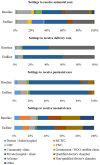Strengthening the community support group to improve maternal and neonatal health seeking behaviors: A cluster-randomized controlled trial in Satkhira District, Bangladesh
- PMID: 30817784
- PMCID: PMC6394907
- DOI: 10.1371/journal.pone.0212847
Strengthening the community support group to improve maternal and neonatal health seeking behaviors: A cluster-randomized controlled trial in Satkhira District, Bangladesh
Abstract
Background: Although achieved development goals on maternal and child health, in the era of Sustainable Development Goals (SDGs), Bangladesh still needs to promote skilled attendance at birth as well as a continuum of care for mothers and babies. How to implement effective interventions by strengthening the community health system also remains as a crucial policy issue. The objective of the proposed study is to evaluate the impact of a community-based intervention as part of a bilateral development aid project on utilization of maternal and neonatal care provided by skilled providers and qualified facilities.
Methods: A cluster randomized trial was conducted in Kalaroa Upazila of Satkhira District. Community Clinics (CCs) in the study setting were randomly allocated to either intervention or control. We recruited all eligible women covered by CC catchment areas who gave a birth during the past 12 months of data collection at the baseline and end-line surveys. In the intervention areas, three Community Support Groups (CSGs) were developed in each of the CC areas. The members of CSG were trained to identify pregnant women, educate community people on pregnancy related danger signs, and encourage them for utilization of skilled services in the community and health facilities. The primary outcomes were the utilization of services for antenatal care, delivery, postnatal care and sick newborns. Difference-in-Difference (DID) analysis was performed to identify the changes by the intervention with adjustment of cluster effects by generalized mixed effects regression models.
Result: The major indicators of the utilization of maternal and neonatal care among pregnant women with different wealth status showed significant improvement after the intervention. The impacts of the intervention were in particular significant among the women of 2nd and 3rd quintiles of household wealth status. The use of CCs increased after the intervention and private hospitals / clinics served as the major health providers. The study also identified increased practices of cesarean section.
Conclusion: The success of the intervention suggests a potential of the government efforts to strengthen the community support system for promotion of safe motherhood. The intervention helps to identify and remove existing and emerging barriers that lie between women and healthcare providers for safe motherhood and continuum of care.
Trial registration: UMIN Clinical Trial Registry UMIN000031789.
Conflict of interest statement
The authors have declared that no competing interests exist.
Figures
References
-
- General Economics Division, Planning Commission of Government of the People’s Republic of Bangladesh, UNDP Bangladesh. Millennium Development Goals Bangladesh Country Report 2013. 2014.
-
- El Arifeen S, Hill K, Ahsan KZ, Jamil K, Nahar Q, Streatfield PK. Maternal mortality in Bangladesh: A countdown to 2015 country case study. The Lancet. 2014; 384 (9951): 1366–74. - PubMed
-
- Sustainable Development Goals. Goal 3: Ensure healthy lives and promote well-being for all at all ages. http://www.un.org/sustainabledevelopment/health/, Accessed 29 March, 2018.
-
- General Economics Division, Planning Commission of Government of the People’s Republic of Bangladesh. Mapping of Ministries by Targets in the implementation of SDGs aligning with 7th Five Year Plan (2016–2020). 2016.
Publication types
MeSH terms
Associated data
- Actions
LinkOut - more resources
Full Text Sources
Medical
Miscellaneous





